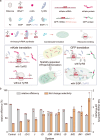De novo engineering of programmable and multi-functional biomolecular condensates for controlled biosynthesis
- PMID: 39284811
- PMCID: PMC11405872
- DOI: 10.1038/s41467-024-52411-5
De novo engineering of programmable and multi-functional biomolecular condensates for controlled biosynthesis
Abstract
There is a growing interest in the creation of engineered condensates formed via liquid-liquid phase separation (LLPS) to exert precise cellular control in prokaryotes. However, de novo design of cellular condensates to control metabolic flux or protein translation remains a challenge. Here, we present a synthetic condensate platform, generated through the incorporation of artificial, disordered proteins to realize specific functions in Bacillus subtilis. To achieve this, the "stacking blocks" strategy is developed to rationally design a series of LLPS-promoting proteins for programming condensates. Through the targeted recruitment of biomolecules, our investigation demonstrates that cellular condensates effectively sequester biosynthetic pathways. We successfully harness this capability to enhance the biosynthesis of 2'-fucosyllactose by 123.3%. Furthermore, we find that condensates can enhance the translation specificity of tailored enzyme fourfold, and can increase N-acetylmannosamine titer by 75.0%. Collectively, these results lay the foundation for the design of engineered condensates endowed with multifunctional capacities.
© 2024. The Author(s).
Conflict of interest statement
The authors declare no competing interests.
Figures






Similar articles
-
Light-induced programmable solid-liquid phase transition of biomolecular condensates for improved biosynthesis.Trends Biotechnol. 2025 Jun;43(6):1403-1424. doi: 10.1016/j.tibtech.2025.02.012. Epub 2025 Mar 12. Trends Biotechnol. 2025. PMID: 40082181
-
CRISPR/Cas13X-assisted programmable and multiplexed translation regulation for controlled biosynthesis.Nucleic Acids Res. 2025 Jan 7;53(1):gkae1293. doi: 10.1093/nar/gkae1293. Nucleic Acids Res. 2025. PMID: 39777467 Free PMC article.
-
Modular pathway engineering of key carbon-precursor supply-pathways for improved N-acetylneuraminic acid production in Bacillus subtilis.Biotechnol Bioeng. 2018 Sep;115(9):2217-2231. doi: 10.1002/bit.26743. Epub 2018 Jul 12. Biotechnol Bioeng. 2018. PMID: 29896807
-
Phase-separated biomolecular condensates for biocatalysis.Trends Biotechnol. 2024 Apr;42(4):496-509. doi: 10.1016/j.tibtech.2023.10.003. Epub 2023 Nov 2. Trends Biotechnol. 2024. PMID: 37925283 Review.
-
Liquid-liquid phase separation in microorganisms: Insights into existence, functions, and applications.Microbiol Res. 2025 Mar;292:128026. doi: 10.1016/j.micres.2024.128026. Epub 2024 Dec 17. Microbiol Res. 2025. PMID: 39705832 Review.
Cited by
-
Coacervates as enzymatic microreactors.Chem Soc Rev. 2025 May 6;54(9):4183-4199. doi: 10.1039/d4cs01203h. Chem Soc Rev. 2025. PMID: 40084439 Free PMC article. Review.
-
Toward Design Principles for Biomolecular Condensates for Metabolic Pathways.Adv Biol (Weinh). 2025 May;9(5):e2400672. doi: 10.1002/adbi.202400672. Epub 2025 Apr 7. Adv Biol (Weinh). 2025. PMID: 40195042 Free PMC article. Review.
References
Publication types
MeSH terms
Substances
LinkOut - more resources
Full Text Sources

